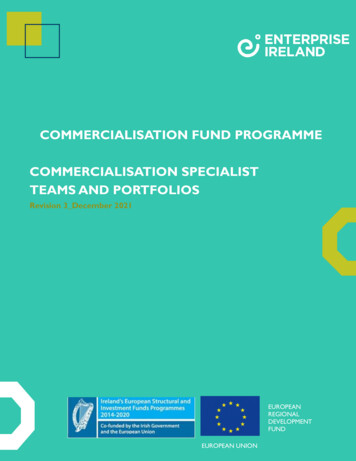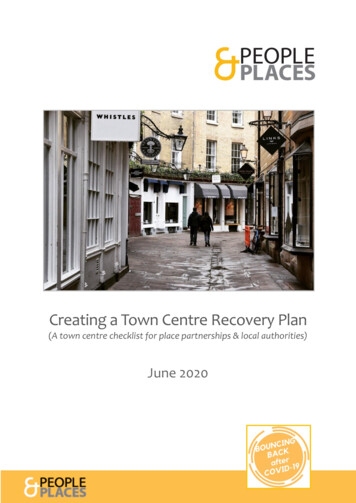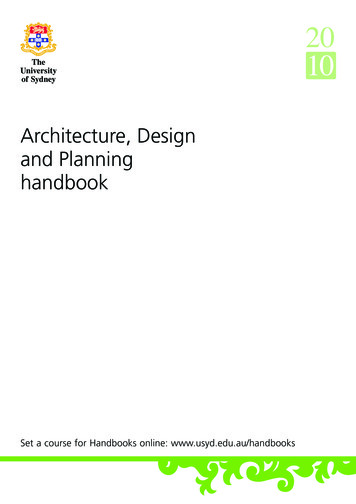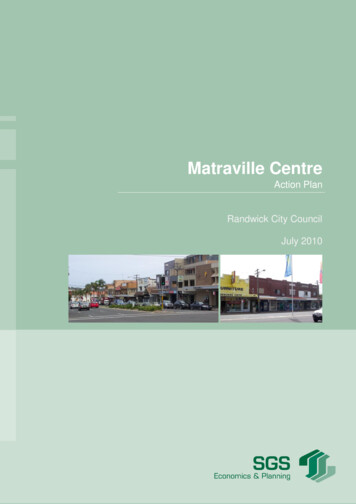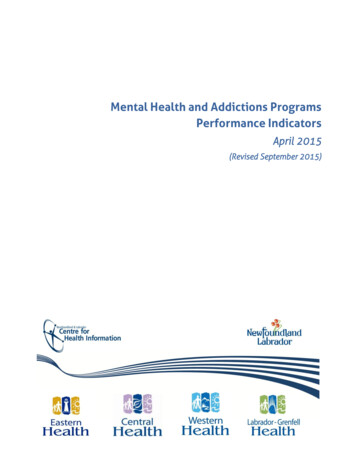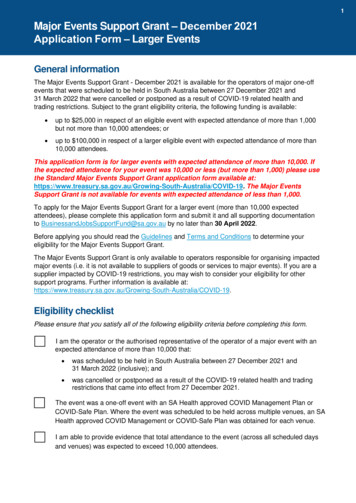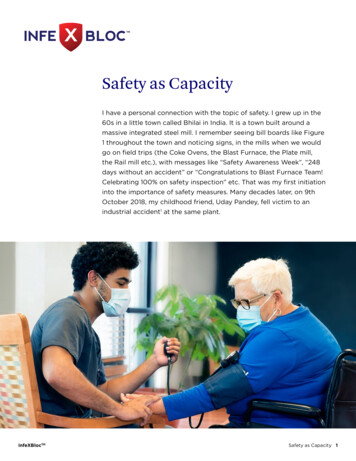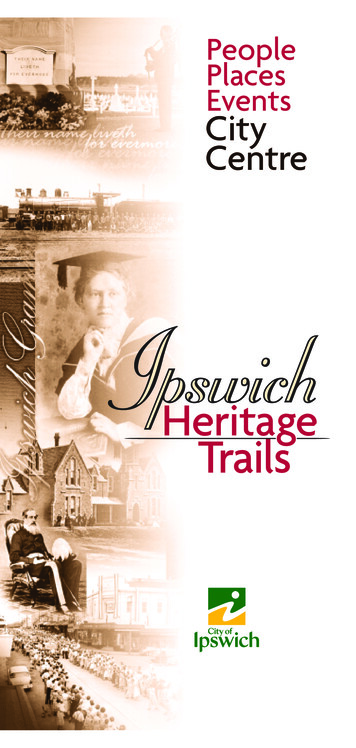
Transcription
PeoplePlacesEventsCityCentre
STREETHUNTER1516141817119 205462 38 79132122
101112BLACKSTONEROAD23ROBERTSONROAD
1 Old Flour MillIn 1935, radio station 4IP started broadcasting from the upperfloors of the Old Flour Mill.It was a commercial stationbut very much a localenterprise. The companywas founded by F.W.Johnson. It concentrated onlocal news and broadcastsby local performers.Old Flour MillClarkes shoes in store promotionwith 4IP radio, 1969, PIF. W. Johnson & Sons City Motor Works, ca. 1930, PI2 Soldiers Memorial HallGeneral Sir William Birdwood laid the foundation stone in 1920.Affectionately known as “the Digger-in-Chief”, he had been one ofthe commanders of theANZAC forces.The Hall was designedby architect GeorgeBrockwell Gill who alsodesigned the adjacentTechnical College.Soldiers Memorial Hall, early 1920s, PI3 Civic CentreThe Civic Centre was opened byPrime Minister Gough Whitlamin July 1975.Prime MinisterGough Whitlam, PICivic Hall, 1975, P.I.
4 Old Town HallThe Town Hall was built in the 1860s as aSchool of Arts. When the organisation hadfinancial problems, it was purchased by theCouncil for a Town Hall. It is now part of theIpswich Art Gallery. The building has beenassociated with many notable people.Members of Council include:Vi JordanIn 1961, Vi Jordan was the first woman elected to Ipswich CityCouncil. In 1966, she was the second woman to be elected toQueensland Parliament and the first woman to represent theLabor Party.James FinimoreLong-serving Mayor 1949-1973 who had been a POW atChangi prison during World War II.Arthur MacalisterAlderman 1862-63, later becoming Premier of Queensland.Frank CooperAlderman 1924-1927, later becoming Premier of Queensland.Visiting speakers or performers included:1901: Australian bush poet Banjo Patterson.1906: Governor-General Lord Northcote.1927: World famous singer Dame Nellie Melba.1947: Aboriginal tenor Harold Blair (who grew up at Purga Mission).Visiting Australian Prime Ministersincluded William Morris Hughes,John Curtin and Robert Menzies.An unusual activity occurred in 1911when a Bleriot Monoplane, the firstaeroplane seen in Ipswich, was puton display inside the hall andthe engine wasstarted. Two menmanaged to holdthe plane down.Portrait of Harold Blair,Australian AboriginalTenor, NLA ID 3670523Town Hall, Ipswich, 1933, PI
BenjaminCribb, PICribb & Foote store, ca. 1940, PI5 Cnr Brisbane and Bell Streets1849: Benjamin Cribb opened “London Stores” in Bell Street.Six years later, he took his brother-in-law John Foote intopartnership and the firm became “Cribb & Foote”.The firm expanded with new buildings, new departmentsand a mail order section until it became one of the largestin Queensland.1972: Walter Reid & Co purchased Cribb & Foote.1985: On the 17 August, the buildings were destroyed by a fire.For some time, there was an empty space in the heart ofIpswich. A new development, Ipswich City Square beganthe following year. In 2013, this was in turn replaced by theIcon Ipswich office tower.Reid’s fire aftermath, 1985, PI
6 Hudson's Eumenthol JujubesIn the buildings below the Post Office, there have been severalchemist shops including that of George Hudson who inventedEumenthol Jujubes in the1890s. They became sopopular that Hudson movedto Sydney in 1907 toexpand his manufacturingprocess and the throatpastilles became famousthroughout Australia.Hudson lived at ‘Rose Hill’near what is now CintraStreet, Eastern Heights.7 Devil's Gully, Marsden ParadeEumenthol Jujubesbuilding, SLQChinese gardens were flourishing here in the 1880s.The devil supposedly appeared in a rush of wind and frightenedMrs Stewart while she was waiting for her husband William toreturn from work. The area has been called Devil's Gully ever since.8 Convict stockyard and shearing shed, Wharf and East StreetsIn the convict era, a large stockyard was built across what waslater Wharf Street, near the intersection with Brisbane Street.It was divided into two sections and was used for both sheepand cattle. A shearing shed was nearby, on the western side ofpresent-day East Street.Panorama of the1842 Plan for thetown of Limestone,later called Ipswich basedon Henry Wade’s Survey Map
Wilson family, Claremont, 1912, SLQ9 ClaremontJohn PantonClaremont was built for merchant John Panton and his wifeIsabella in 1856-57.George ThornIt was later owned by George Thorn who wassent to Moreton Bay in 1839 to take charge ofthe Limestone Hills convict outstation.He remained in Ipswich when free settlementwas allowed, opened hotels and a merchantbusiness, owned country properties and waselected to the first Queensland Parliament.George ThornSenior, SLQGeorge Thorn JnrHis son George Thorn Junior became thePremier of Queensland in 1876 and lived atClaremont. Three other sons Henry, John andWilliam were also elected to Parliament atvarious times, making five members fromthe one family.George ThornJunior, SLQBrisbane Hunt Club outside George Thorn’s residence, ca. 1894, SLQ
10 Cunningham’s KnollLime HummockThe lime hummock on the knoll is a reminder of the lime-burningoperations established in 1827 by the Commandant of the MoretonBay penal settlement, Captain Patrick Logan.An overseer and five convicts were stationedat Limestone Hills to quarry and burn theLimestone.Patrick LoganMitchell Library,SLNSW, ML 13Cunningham MonumentCommemorates the visits of explorer Alan Cunningham.He is unlikely to have actually camped under the fig trees in 1828,but definitely camped nearby.Glassey MonumentThomas Glassey is regarded as the first “labor” member ofQueensland Parliament (before the Labor Party was officiallyestablished). He was elected in 1888 after calling for reformssuch as an eight-hour day and a minimum wage.The beautification of Limestone Hill was the vision of Parks CuratorF. W. Turley. Most of the work was carried out as part of a ReliefWork Scheme during theDepression of the 1930sincluding the terracedpyramid, limestone gardensand walls, the side roadand a “boulevard” throughthe Park.11 Ipswich Girls’ GrammarSchoolandEleanor ConstanceGreenhamIpswich Girls’ GrammarSchool was opened in 1892.The first student to enrol wasa local girl, EleanorConstance Greenham.She later became the firstQueensland-born woman tobe registered as a medicalpractitioner.Eleanor Constance Greenham, IGGS
12 Queens ParkThe park first opened in 1863. The earlybeautification of the park was the work of longserving curators Alexander Munro (1881-1909)and Frederick Turley (1909-1935).Queens Park, 1930s, PIQueen Elizabeth, the Queen Motherwith Ipswich MayorJames Finimore, 1958, PIWhen important peoplevisited Ipswich, a civicreception was often heldin Queens Park.Notable visitors included:1920: Prince of Wales who later became King Edward VIII butabdicated to marry Mrs Simpson.1920: General Birdwood who presented service medals to returnedsoldiers.1920: Duke and Duchess of York later King George VI and QueenElizabeth.1958: Queen Elizabeth, the Queen Mother.Queens Park Band rotunda, ca. 1940s, PI
Opening of the Incinerator, 1936, PI13 Walter Burley Griffin Incinerator1936: Walter Burley Griffin Incinerator opened at Queens Park.The incinerator was erected in 1936 to burn the city's garbage.It was designed by Walter Burley Griffin, the architect who, withhis wife Marion Mahoney,Rear view of the Incinerator, 1936, PIdesigned the Australiancapital city Canberra.When it was completedthe newspapercommented that it was“an attractive structure”.By 1960, burning rubbishwas not consideredenvironmentallyacceptable and theincinerator was no longeradequate for theexpanding population.The Incinerator is now theheadquarters of IpswichLittle Theatre.Opening of the Incinerator, 1936, PI
14 River Heart ParklandsThe Parklands are situated on the southern bank of the BremerRiver. Stage 1 of the Parklands runs from the Bradfield Bridge tothe David Trumpy Bridge and Stage 2 runs further east down toBob Gamble Park on King Edward Parade andis connected by a succession of boardwalks.Stage 1 of the parklands wasofficially opened in 2007 andStage 2 opened in 2012.Bradfield BridgeA new pedestrian bridgeopened in 2010. It wasnamed after the engineerJohn Bradfield who grew upin Ipswich.He was responsible for thedesign of Sydney HarbourBridge and Story Bridgein Brisbane.RiverheartParklandsStage 1John Bradfield1886, PIBradfield Bridge 2010, Lyle Radford, PIDavid Trumpy BridgeA new road bridge was opened in June 1965, 100 years after thefirst bridge over the Bremer. It was named after Dr David Trumpy,who was a long-serving andhighly-regarded superintendentof Ipswich Hospitalfrom 1920 until1967.David Trumpy Bridge, 1987, PIPortrait ofDr David TrumpySLQTown Bridge, early 1960s, PI
Lt John Oxley and Allan CunninghamIdentified and named the junction of the BremerRiver in 1824 while exploring the BrisbaneRiver. Patrick Logan was the first to investigatethe Bremer, coming as far as the site of modernIpswich in a boat rowed by convicts.FloodsThe worst floods recorded in Ipswich werein 1893, 1974 and 2011.Allan CunninghamSLQLithograph of flood, 1870, PIBrisbane Street, 1893 flood, PIBrisbane Street, 1974 flood, PIFirst RailwayThe large sandstoneabutments on each sideBrisbane Street, 2011 flood, PIof the river are theremains of the 1865 road/rail bridge, built as part of the firstsection of railway between Ipswich and Grandchester. Called theBremer Bridge, it catered for both vehicular and railway use.In 1897 a separate structure was erected up stream for railwaypurposes and the old bridge was then used entirely forvehicular traffic.The original 1865 bridge with two newer rail bridges adjacent, PI
Vickers Vimy aircraft of brothers Rossand Keith Smith undergoing repairs1920, PI15 Ipswich Railway WorkshopsRailway workshops were built at Ipswich in 1864 close to thelocation of the first railway in Queensland. The railway workshopswere needed to assemble the locomotives and rolling stock andundertake repairs for the new railway.For decades the site was the centre of rail construction,maintenance and technology for Queensland’s burgeoning railindustry. In its time more than 200 steamlocomotives were constructed there.Thousands of workers have calledThe Workshops their home over the years.During its peak in World War II,more than 3,000 people workedon site.The workshops experienced arebirth when in 2002 the sitebecame a world class interactiverail museum.1919: One unusual task which demonstrated the ability of therailway workers was the repair of an engine and propellerfor Ross and Keith Smith. Their plane had been damagedat Charleville in December 1919 after winning a prize forcompleting the first flight from England to Australia in lessthan 30 days.1923: The Ipswich Railway Workshops celebrated the buildingof its 100th locomotive, a C19 steam engine.100th locomotive, C19 steam engine, 1923, PI
16 Panton’s Cotton FarmJohn Panton's cotton farm was on the riverbank atWoodend bounded by Macgregor, Hume andPanton Streets. After several years of experiments,Panton harvested the first commercial crop ofcotton in 1862 and sent it to mills in Manchester,England. Cotton growing became a majorJohn Pantonindustry throughout the region State of New South WalesParliament of New South Walesfor several years.Bill of lading17 Ipswich Grammar SchoolGovernor Bowen, SLQGovernor BowenThe Governor of Queensland,Sir George Ferguson Bowenofficially opened the IpswichGrammar School on 25 September,1863. This was the first secondaryschool in Queensland.Duke of EdinburghDuring a two-day visit to Ipswich in 1868, the Duke of Edinburgh(the son of Queen Victoria) climbed the Ipswich Grammar Schooltower, admired the view and signed the visitor's book.The Duke was bored and very aloof during his stay and thetownspeople were upset – the newspaper said that “we regretsincerely that the Duke of Edinburgh ever came to Ipswich”.Ipswich Grammar School, PI
Aftermath of storm, 1930, PI18 Blair State SchoolIn 1930 a massive thunderstorm withheavy hail and strong winds brokeover Ipswich.A new wing of Blair State Schoolcollapsed during the fierce storm.The wind had swept under the building,twisting it and snapping off the bricksupporting piers about a metre above theground. The new block totally collapsed.Fortunately, no one was hurt – schoolhad finished for the day and a cleaner hadjust left the building.19 Dr Von Lossburg’s HouseThe Northern HeraldNovember 1930, NLAGerman doctor William Henry Von Lossburg arrived inQueensland in 1863 and set up practice in Ipswich, oftenriding on horseback to see country patients. He was anhonorary surgeon at Ipswich Hospital andwas the Government Medical Officer.He practised for more than 50 years andat the time of his retirement, he was theoldest doctor registered with the BritishMedical Association.William HenryVon Lossburg, SLQ
20 Dr Flynn’s HospitalDr Flynn started St. Mary’s Hospital in Roderick Street inMay 1906. It catered for 12 patients and had its own operatingroom and dispensary. The building which still exists, now calledCarrington Guesthouse, was designed by architect Henry Wymanand was built by Con Madden.In 1919, the Spanish Influenzapandemic reached Ipswich –a serious illness which killed50 million people around the world.Doctor Flynn worked tirelessly toattend patients. He became ill withthe flu himself and died a week later,age 49.Ipswich was greatly affected bythe death of the highly regardedDoctor. It was said that he had“sacrificed his life through greatdevotion to his work”.The QueenslanderMay 1906, NLASt Mary’s HospitalAdvertisementca. 1910, PI
21 Denmark HillCocky Jerry JarA small cave on Denmark Hill was once the home of a Chineseman known as “Cocky Jerry Jar”. According to local stories, hisreal name was Ti.‘Cocky Jerry Jars’ Cave, ca. 1947, PIHe had been cheatedout of money he hadsaved and then cameto live in this cave,making a living byselling firewood anddoing odd jobs.He was often teasedby local boys.QT IpswichJuly 1945, NLABlackall Memorial1961, PIGovernor Blackall, SLQGovernor BlackallThe Blackall Memorialhonoured popularGovernor SamuelWensley Blackall whodied while in office in1871 after contracting aterminal illness.Governor Blackall was onlyin office for a short period,but gained a high publicregard during this time.The monument wasoriginally located at theintersection of Brisbane andNicholas Streets, but wasmoved to Denmark Hill.
22 Nerita Gates, Ipswich ShowgroundIn June 1939, the Nerita, a 45 foot motor launch, went out intoMoreton Bay with 12 people on board, seven from Ipswich.When the boat was overdue for its return, a large scale searchwas initiated, which included the use of aircraft.The men were never seen again andafter a long search only an upturneddingy was found.A memorial service for those lost washeld in Ipswich. The Nerita gates andplaque were erected in memory of thevictims of the Nerita launch disaster.23 Grange Racecourse, RaceviewNerita Memorial Gates plaque, PIIn 1861, a Champion Sweepstakes was held in Ipswich. The prizemoney was huge for that time, 1100, higher than the MelbourneCup the same year. The race was won by Zoe, a horse brought upfrom NSW by steam ship. Zoe was later celebrated by a paintingcalled “Zoe” and a piece of music called “The Zoe Gallop”.“Zoe” Source: W. F. Emery, NLA, an. 9778174
Explore FurtherIf you have enjoyed this guide to the city centre of Ipswich, there aremany other brochures, heritage trails and booklets to helpyou explore further.These are available at the Ipswich Visitors Information Centre located atQueens Park, 14 Queen Victoria Parade (Brisbane Road), Ipswich.Access is from Chermside Road and Queen Victoria Parade.The centre is open seven days a week. Staff can help you plan your dayin Ipswich and can make bookings for accommodation includingmodern motels and historic homestays. It can also provide a guideservice for groups.For further information contact:Ipswich Visitor Information Centre (07) 3281 0555or visit our website: www.discoveripswich.com.auPeople Places Events brochures can be downloaded free from thecouncil website: www.ipswich.qld.gov.au/about ipswich/heritagePlease Note:Thissymbol indicates that there is a ‘Historical Marker’(brass plaque) at this site.Following abbreviations of photographic sources:IGGS - Ipswich Girls Grammar SchoolNLA - National Library of AustraliaPI - Picture IpswichSLNSW - State Library of New South WalesSLQ - State Library of ABRISBANEFirst EditionNovember 2016IpswichGOLDCOASTSouth East Queensland
such as an eight-hour day and a minimum wage. The beautification of Limestone Hill was the vision of Parks Curator F. W. Turley. Most of the work was carried out as part of a Relief Work Scheme during the Depression of the 1930s including the terraced pyramid, limestone gardens and walls, the side road and a "boulevard" through the Park.
